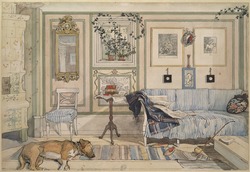Plik:Cosy Corner. From A Home (26 watercolours) (Carl Larsson) - Nationalmuseum - 24210.tif

Wielkość pliku podglądu JPG dla pliku TIF: 800 × 549 pikseli Inne rozdzielczości: 320 × 220 pikseli | 640 × 439 pikseli | 1024 × 703 pikseli | 1280 × 879 pikseli | 2560 × 1757 pikseli | 3547 × 2435 pikseli.
Rozmiar pierwotny (3547 × 2435 pikseli, rozmiar pliku: 24,73 MB, typ MIME: image/tiff)
Historia pliku
Kliknij na datę/czas, aby zobaczyć, jak plik wyglądał w tym czasie.
| Data i czas | Miniatura | Wymiary | Użytkownik | Opis | |
|---|---|---|---|---|---|
| aktualny | 19:35, 7 paź 2016 |  | 3547 × 2435 (24,73 MB) | AndreCostaWMSE-bot | {{Artwork |other_fields_1 = |artist = {{Creator:Carl Larsson}} |title = {{en|Cosy Corner. From A Home (26 watercolours)}} {{sv|Lathörnet. Ur Ett hem (26 akvareller)}} |wikidata = Q18587406 |object_t... |
Lokalne wykorzystanie pliku
Następujące strony korzystają z tego pliku:
Globalne wykorzystanie pliku
Ten plik jest wykorzystywany także w innych projektach wiki:
- Wykorzystanie na cs.wikipedia.org
- Wykorzystanie na en.wikipedia.org
- Wykorzystanie na la.wikipedia.org
- Wykorzystanie na no.wikipedia.org
- Wykorzystanie na sk.wikipedia.org
- Wykorzystanie na sv.wikipedia.org
- Wykorzystanie na sv.wikisource.org
- Wykorzystanie na tr.wikiquote.org
- Wykorzystanie na www.wikidata.org





